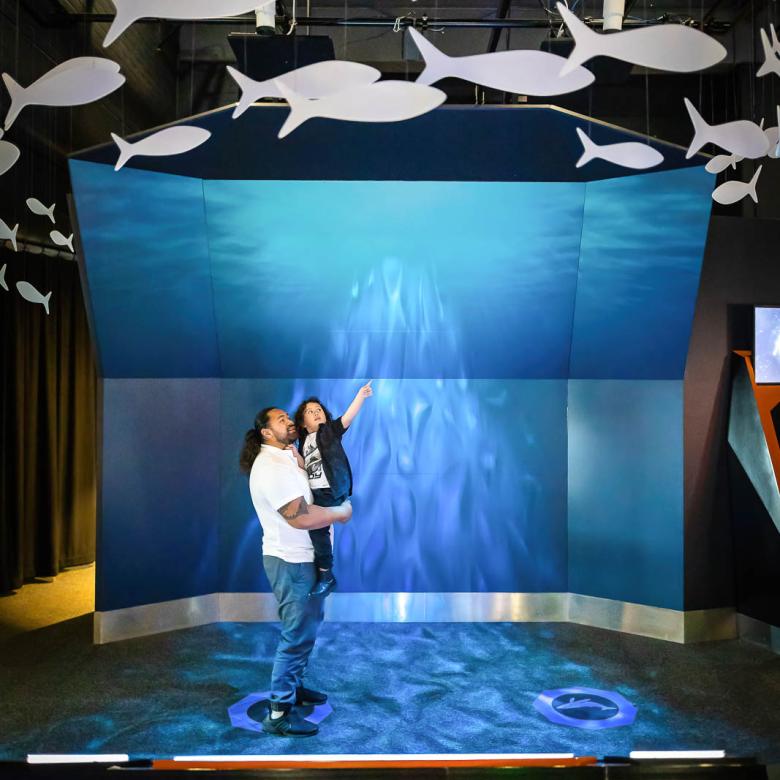About
Human ears don’t work well underwater, so most of us don’t realise just how full of sound our oceans are! Scientists use underwater microphones (called hydrophones) to investigate these sounds. Where do they come from? What do they mean?

Healthy coral reefs are noisy!
Healthy reefs are full of life – and sound! In places like Ningaloo and the Great Barrier Reef, scientists are using underwater speakers to play sounds from healthy reefs to damaged coral reefs.
The healthy reef recordings attract some of the fish life that has been lost from damaged reefs. These fish help corals grow back. Some fish species eat the algae that competes with corals, and fish dung adds nutrients to the reefs. Scientists are using sound recordings as part of new coral restoration projects! We still know very little about how these sounds influence reef life.
Learn more about the Australian Institute of Marine Science’s Reef Song Project.
Listen to the Coral Reef underwater story.
We hear the sounds of coral reef animals, which sound a bit like a sizzling frying pan.
The narrator has a happy woman's voice.
Narrator: This is what a healthy coral reef sounds like! There's quite a lot going on, isn't there? The corals don't make any sounds! So who's so noisy? These are thousands of hunting snapping shrimp! The little shrimp make air bubbles with their claws. When the bubbles burst they make this loud crackling sound.
The narrator pauses. Amid the sizzling is a sound similar to a pigeon cooing.
Narrator: Different reef fishes like this sergeant major join in. And can you hear the quiet whooping of the ambon damselfish? It sounds like a bird, doesn't it?
The narrator pauses again. There's a hooting sound similar to an owl hooting.
Narrator: These healthy reef noises tell baby reef fish that this is a great place to live. In fact, scientists are using recordings like this to attract baby fish back to damaged reefs. The fish are important because some eat algae that would otherwise overgrow the corals. Their poo even fertilises the reef! These recordings are an exciting part of some new coral restoration projects.
The sizzling reef noises fade out.

Songs of Giants
Humpback whales migrate further than any other mammal on Earth! Twice a year, humpbacks travel more than 5,000 km up and down the east and west coasts of Australia. Humpbacks were close to extinction in the 1960s, but now that they are protected, they have recovered.
To help protect whales and dolphins:
- Don’t litter! Rubbish that goers into our oceans can end up in a whale’s or a dolphin’s stomach.
- Always stay at least 100 m away from whales and dolphins. Don’t touch or feed them, even if they approach you.
- Report any injured or stranded whales or dolphins to your local environment agency.
Listen to the Singing Humpback Whales underwater story.
We hear the sound of a humpback whale singing. The sounds are long, eerie notes which gradually slide from one pitch to another.
The narrator speaks with a deep male voice over the whale song.
Narrator: Do you recognise this sound? A male humpback whale singing! Doesn't he sound eerie?
The narrator pauses, and we hear more humpback whales singing.
Narrator: These howls and moans can go on for hours and only the migrating males sing! We think that the songs charm the females and tell other males to stay away. All males off the east coast of Australia sing the same song – but males off the west coast sing a different song!
The audio shifts to a different whale song, made of shorter, squeakier and more high-pitched notes.
Narrator: These songs change slowly over time. Fancy that! The whales seem to learn the new song from each other while migrating along the same routes. Humpback whales are amazing, aren’t they!
The sounds of humpback whales singing fades out.

Too much noise can be painful
In busy shipping lanes, natural sounds are being drowned out by human-made noises, which are making animals behave differently.
To discover exactly how many ships are at sea at any given moment, check out the Marine Traffic live map.
Shipping noises are stressful for many marine animals. Loud noises like sonar can damage a whale’s hearing or make it hard for them to communicate with each other.
But, there are some solutions. New laws limit some types of noise pollution in the ocean, and new propeller and sonar designs can help make ships a bit quieter.
Listen to the Noise Pollution underwater story.
We hear a faint sloshing noise, and the shimmering sound of rain falling onto the surface of water.
A female narrator speaks over the sounds.
Narrator: Imagine you are a fish or whale living in the ocean. You might hear the sound of rain and waves breaking above you.
The narrator pauses, and there's the sound of a vast electrical echo as lightning strikes the water.
Narrator: You might even hear a loud thump of lightning striking the ocean surface!
The narrator pauses again, and there's a noise that sounds similar to cars on a distant racetrack.
Narrator: And if you live under the sea ice in Antarctica you might hear icebergs scrape against each other. Scientists had to speed up this recording so humans can hear it! Ocean animals are used to all these background noises. But listen to this!
The narrator pauses again, and there's a loud, rhythmic mechanical noise, which sounds similar to a truck driving past.
Narrator: A large cargo ship is passing by. In busy shipping lanes, it might get so loud that it hurts your ears or makes it hard to hear others of your kind. You might also hear sonar noise, underwater seismic testing and more. Some companies are now testing ships with quieter propellers. That’s a good start, but we still have a long way to go. Thankfully, unlike other types of pollution once noise pollution is gone, it’s gone for good.
The noise pollution fades, and we hear the shimmering sound of rain again. Then all sounds fade away.

Hungry newcomers
Long-spined sea urchins mostly eat algae. They are an important part of a healthy ecosystem, but there is such a thing as too many sea urchins! Sea urchins can devour entire kelp forests, leaving nothing but bare rock behind. And they’re getting more common…
Climate change has changed the ocean’s currents. Now, the currents are carrying urchin larvae from New South Wales, their usual home, south into Tasmania.
These invading sea urchins are destroying large areas of kelp forest in Tasmania. This can cause the local food chain, which wildlife and fisheries rely on, to collapse. By protecting our rocky shores and making sure there are plenty of natural predators around to keep urchin numbers down, we can help tackle this challenge.
Listen to the Sea Urchins underwater story.
We hear a crackling, sizzling sound similar to oil in a frypan.
The narrator speaks over the sounds with a deep male voice.
Narrator: What would make such crackling noises? It's a sea urchin! In fact, it's many sea urchins moving about and feeding. Long-spined sea urchins make this sound when they scrape kelp off rocks with their five razor-sharp teeth. They are an important part of a healthy ecosystem but they love kelp so much they can devour entire forests of it, which can be a problem. Kelp is an important food source and habitat for many other animals, and when the kelp goes these animals go too. In Tasmania, the East Australian Current, made stronger by climate change, is carrying long-spined sea urchin larvae down from their usual home in NSW. Local wildlife and fisheries are suffering because of the damage these urchins are wreaking. These is just one example of why it is so important for us to manage and protect our marine environments.
The crackling, sizzling sounds fade away.
With thanks to:
- Dr Mark Meekan, Australian Institute of Marine Science
- Dr Tim Gordon, University of Exeter
- Dr Nathan Knott, NSW Department of Primary Industries
- Prof Maria Byrne, University of Sydney
- Dr Natalie Soars, University of Sydney
Audio credits
- Sea urchins – Dr Natalie Soars, University of Sydney
- Layered reef sounds – Dr Tim Gordon, University of Exeter
- Snapping shrimp and sergeant major – Prof Steve Simpson, University of Exeter
- Ambon damselfish – Prof Eric Parmentier, University of Liège
- Humpback whale songs – Prof Robert McCauley, Curtin University
- Icebergs underwater – Centre for Marine Science and Technology, Curtin University
- Sounds of Rainfall, Sonatech Inc. CC BY-NC 3.0
- Sound of Lightning, Henry Bass, Roy Arnold and Anthony Atchley, National Center for Physical Acoustics, CC BY-NC 3.0
- Large Commercial Ship, Thomas R. Kieckhefer, CC BY-NC 3.0
- Merchant Vessel, Peter M. Scheifele, Department of Communication Sciences and Disorders and Medical Education, University of Cincinnati Medical Center, CC BY-NC 3.0
Image credits
- Coral reef – Dr Tim Gordon
- Humpback whale migration data – Department of Environment
- Long-spined sea urchins – Dr Natalie Soars



